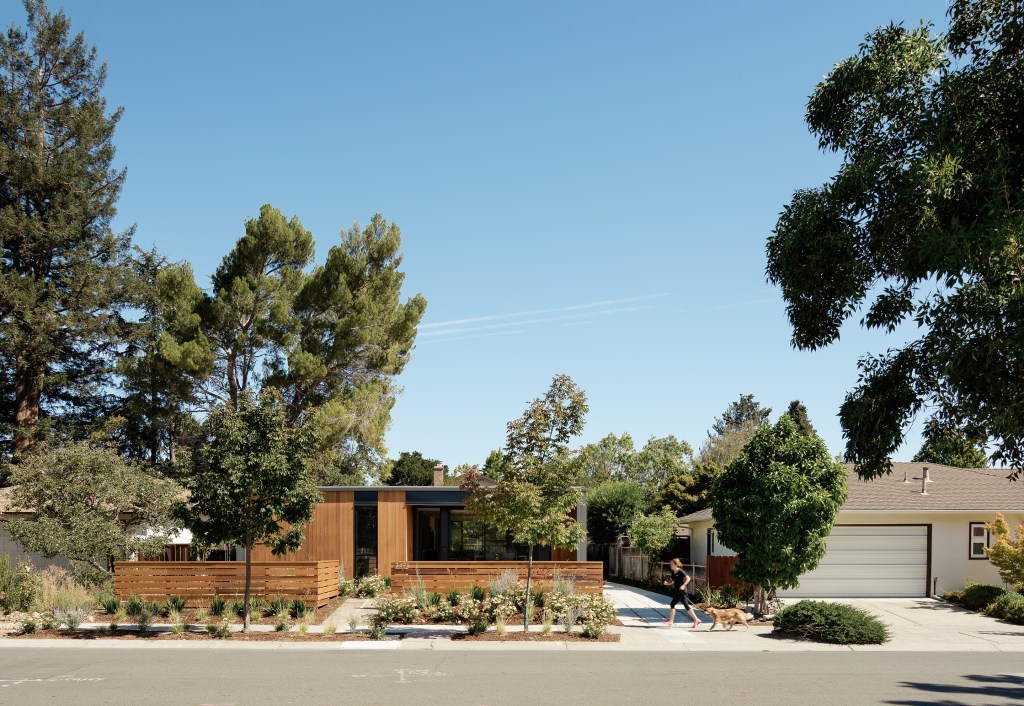Nearly 15,000 homes were damaged or destroyed during the October 2017 wildfires that raged across Northern and Southern California, leaving thousands of families homeless. Due to a severe construction labor shortage and the need for soil testing and permitting on the affected sites, many residents will wait years, not months, to rebuild.
They will wait, that is, unless they are clients of Palo Alto, Calif.-based Connect Homes. The prefab residential design and building company aims to have clients who lost houses into new, non-combustible homes within a year. Bringing quick-build expertise and relying on a carefully chosen palette of fireproof materials, the Connect Homes team is skilled at working on an accelerated construction timeline.
For those who lost their homes to the fires, Connect Homes provides free site assessments, cuts design fees in half, and fast tracks their projects. Around 10 to 15 clients have already signed contracts, and the first few expect to move into their new homes this summer.
In fact, the company’s quickly constructed dwellings will translate into savings of nearly four years and tens to hundreds of thousands of dollars for these homeowners, and its services will no doubt be in demand for homeowners currently dealing with this summer’s wildfire outbreak.
-
How to Build Fire-Proof Homes
When wildfire swept through Bob Heath's neighborhood in Napa, Calif., a lot of other homes in the fire's path burned to the ground. In recent years, as many as 2,000 homes (annually) have been destroyed by wildfire, a loss inflated by drought conditions in both eastern and western states, along with steady encroachment of development onto "frontier" lands.Jim Smalley, manager of wildland fire protection for the National Fire Protection Association (NFPA), notes that some home builders have taken an active role in fire prevention–often getting some perks in the process.
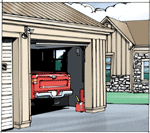
When Gordon Stott founded Connect Homes with Jared Levy in 2012, the architects set out to create a firm to design and build houses with modern aesthetics, sustainable features, and site-specific details for middle-class buyers. The two had worked together for more than five years at award-winning Los Angeles architecture firm Marmol Radziner, where Levy ran the prefab division. Both Levy and Stott felt they could solve the problems keeping high-design prefab houses out of reach for typical home buyers.
Founded with the mission of bringing high-quality design to average home buyers, the company builds houses for about a third of traditional site-built construction costs, based on average costs per square foot in California.
Their approach encompasses an unchanging modular steel structure that allows the company to deliver components via standard shipping containers. This was key to getting costs down, Stott explains.
“There’s no longer a need for wide loads or special permits to drive through each county or state, which means delivering a two-story house to Connecticut costs us around $25,000,” Stott says. The pair had previously calculated a similar delivery with pieces larger than the shipping container would cost around $400,000.
Their other core company philosophy involves thinking of houses like products. Nearly 90% of each Connect house is fabricated in the factory, resulting in significant reductions in cost, time, and waste compared to a site-built dwelling. The various models range from $250 to $300 per square foot, and take about six to eight weeks to build, deliver, and assemble after permitting. While the house is being built in the factory, foundation is laid on-site to prepare for delivery and assembly and expedite the completion timeline, which spans from a few days to a week.
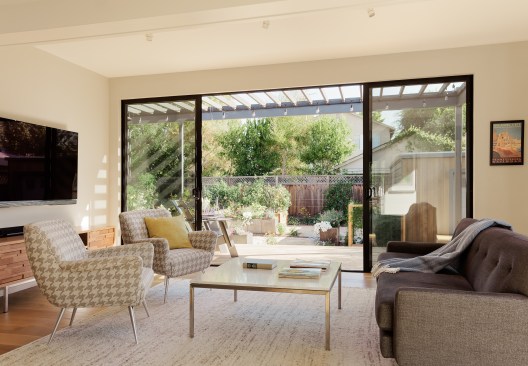
Joe Fletcher Photography
The idea of houses as off-the-shelf products extends to the design process. Levy and Stott created several models with distinct floor plans and programs. Connect Homes received state-level inspections and approvals for building those exact plans—which cuts down on permitting time.
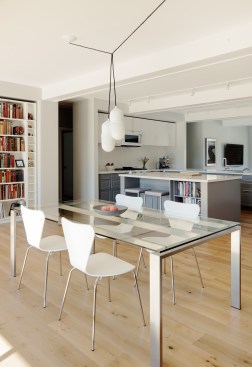
Joe Fletcher Photography
Clients can still individualize their homes to their liking, and are offered material, finish, and color options inside and out. While they can’t change-up wall configurations, they can decide on the amount and placement of windows to maximize views, open up rooms to ocean breezes, or protect interiors from harsh sun exposure. Most models also come with at least one alternative floor plan adjustment. For example, a client can opt to transform the roomy covered deck on one plan into an enclosed dining room.
Some of those same techniques making Levy and Stott’s designs affordable, green, and efficient to build also enhance the houses’ fire resistance. Steel-framed modules that snap into standard shipping container-sized frames solve shipping challenges and make the houses nearly fireproof. The firm’s existing homes weathered the most recent round of fires.
“Almost all of our existing clients ended up having fire on or close to their sites—which is kind of terrifying, really—but none of them burned,” says Stott. “Often, an ember blows on the roof and the air draw from an attic starts the fire, but there are no attic spaces in our houses and rarely overhanging eves. Also, we build using steel assembly, so no place for fire to ignite really.”
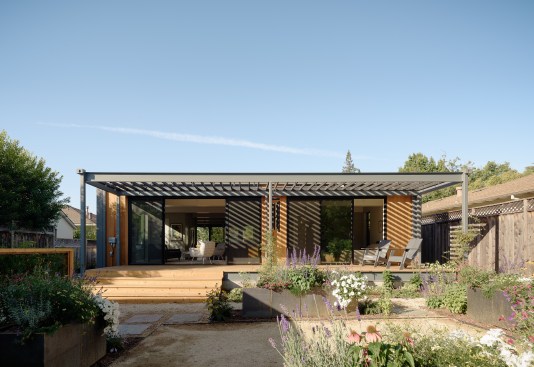
Joe Fletcher Photography
Other materials used to finish exteriors and interiors also boast nonflammable characteristics. As Stott succinctly puts it, “Modern homes look good in aggressively fireproof materials.”
Connect Homes offers all plans in a metal exterior cladding with a resin-based coating—another difficult to burn material. If a client prefers natural wood instead of—or as an accent—to the metal, Levy and Stott use only spec thick , low-combustible cedar that’s slow to ignite and increases fire resistance. Decks are also made from cedar and rest on the ground, so there’s a lack of flame-feeding airflow beneath them.
Inside, homeowners choose from engineered wood and tile for floors and walls. Countertops are almost exclusively done in quartz. Such smooth finishes, combined with open floor plans, clean lines, and abundant glass fit Levy and Stott’s architectural values. The uncluttered style of design also deters leaping flames.
“We use less trim or connections or complicated shapes,” Stott explains, “so the possibility of embers jumping onto a small piece of molding just doesn’t happen.”
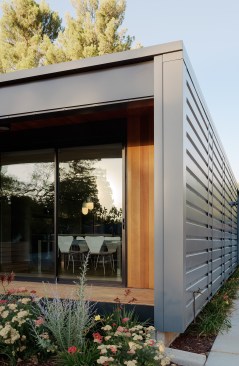
Joe Fletcher Photography
In addition to the inherent lack of combustibility in their modular, modern houses, Connect Homes can add more purposeful fire protection. California already mandates various fire resistant-rated materials depending on the location of the house, but Stott says they give all homeowners—even those in low-risk areas—the option of adding more fire resistance.
“We offer clients a layer of DensGlass,” he adds, “which is a gypsum product often required in high-fire areas.” The fiberglass sheathing, built by Georgia-Pacific, clads the home’s exterior to add increased fire resistance.
Stott also reasons that potential homeowners who approach Connect Homes already want the minimalist aesthetic the company supplies. This sensibility usually extends to landscaping, so most of their sites are similarly void of flammable ornamentation. At least in the area directly surrounding the structure. The company orients each house to best fit existing natural surroundings, which Stott believes makes the concept of designing and selling houses as products feasible for people who want their one-of-a-kind dream homes.
“The reason this works,” the architect explains, “is that every client comes to you with their program and site. A lot of houses share the same program, but no two houses share the same site. So even if the programs are all the same for our houses, each built version is unique.”
While each model Levy and Stott have designed follow a similar footprint, their approach offers clients savings from efficiencies in building identical components over and over, as well as a worry-free building timeline impervious to weather delays or unpredictable subcontractors. Plus, the end result is a precisely put together house with greater durability, energy-efficiency, and air tightness.
“We’ve enjoyed figuring out the great challenge of maintaining a beautiful aesthetic while designing a smarter, better prefab system,” Stott says. “And we felt strongly we wanted to give even more value to homeowners who experienced this terrible event. It feels so good for us to build them a high-design, quality house and save them the agony of labor shortages and other issues after the fires.”
PROJECT DETAILS
Project Connect 6
Location Sonoma County, Calif.
Designer/Builder Connect Homes, Los Angeles
Size 1,920 square feet
Price $430,000
Wildfire Cottage Initiative
Connect Homes is among a handful of local companies chosen to participate in Habitat for Humanity of Sonoma Countyu2019s Wildfire Cottage Initiative, a pilot program that will launch efforts to design and build several temporary cottages for families who have been displaced by the fires. The cottages, which showcase three recent innovative building technologies, will be developed and designed in partnership with Marianne Cusato of Cypress Community Development Corp., who also designed the Katrina cottages after the devastation of Hurricane Katrina in New Orleans.
u201cWith the labor shortage in the building industry, coupled with rising material costs, it is nearly impossible to meet the demand for affordable workforce housing,u201d Cusato says. u201cThis project is a laboratory for the future of residential home building nationwide.u201d
Global medical technology company Medtronic has donated $100,000 and use of land at its Sonoma County division to host up to 10 cottages. The cottages will be designed as efficient, cost-effective, timely, and volunteer-u00adfriendly solutions for long-term affordable and workforce housing in Sonoma County. Rebuild Wine Countryu2014a charitable effort managed by volunteer wine industry professionals from both Napa and Sonoma countiesu2014has raised $1 million with a goal of reaching $5 million for the Sonoma Wildfire Cottage Initiative and additional rebuild efforts by other local Habitat for Humanity organizations in the North Bay.
u201cPrior to the wildfires our affiliate had already begun exploring modern approaches to reduce affordable housing costs while increasing production due to Sonoma County being one of the least affordable counties in the nation,u201d says John Kennedy, interim CEO of Habitat for Humanity of Sonoma County and chairman of the board.
u201cThis pilot project helps us quickly evaluate a variety of technologies while simultaneously helping families in dire need of stable temporary housing,u201d he says.
Construction on the cottages is expected to begin this summer with occupancy slated for late fall.

